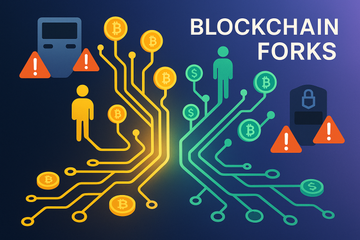There’s something undeniably dramatic about a blockchain hard fork. It’s like watching a long-running TV show suddenly split into two competing spin-offs—each with its own devoted, sometimes stubborn, fanbase. But what exactly is a hard fork in crypto, and why does it make even hardware wallet holders like those clutching their Trezors or Ledgers sit up and take notice?
A Fork in the Road: What Is a Hard Fork, Really?
Let’s not get lost in technical weeds before we’ve unpacked the basics. In the crypto world, a hard fork happens when there’s a major change to the rules of a blockchain. Imagine if the rules of the road changed overnight: stop signs mean go, go signs mean flip a coin, and anyone not on board gets stuck on the old highway. That’s what a hard fork does to the code—permanently splitting a digital highway into two separate paths, each heading in its own direction.
This isn’t a small tweak. It’s like hitting the “update” button on your device, except this time, if you don’t update, your apps suddenly speak another language. In blockchain terms, not everyone agrees to the new rules. So the network splits—one side follows the original code, while the other embraces the new version. Both march ahead, but now they’re different chains longing for consensus that’ll never come.
Why Do Hard Forks Happen, Anyway?
Hard forks aren’t always about drama or dispute. Sure, sometimes deep disagreements cause rifts—think Bitcoin and Bitcoin Cash, or Ethereum and Ethereum Classic. Other times, developers want to fix a bug, boost security, or experiment with wild new features. It’s a bit like roommates arguing over how to organize the kitchen. Some want to rearrange everything; others say, 'Nope, I like it messy!' If neither budges, they might end up with two kitchens, two sets of rules, two worlds within one house.
But here’s the thing: part of what makes blockchain interesting is this very ability to split when consensus fails. Networks aren’t forced to drag unhappy users along. Everyone gets a voice—even if that means walking off to start something new.
Nodes, Wallets, and Real-World Consequences
Let’s talk nuts and bolts. When a hard fork happens, the people running nodes (think of them as blockchain’s tireless traffic cops) have a big choice: update or stay the course. If they don’t agree with the changes, they don’t upgrade and keep policing the old network. If they’re eager for change, they power up the new system.
This isn’t just code talk. For anyone storing their coins with a hardware wallet like a Ledger Nano or Trezor Model T, hard forks can feel a bit nerve-wracking. Suddenly, you face some new questions: Will my wallet support both chains? If there’s a new coin after the fork, do I get it? (Hint: most of the time, yes, but always double-check with your wallet provider before you celebrate.)
- Security risks: Forks can spawn lookalike coins that might be scams—double-check what you’re claiming.
- Compatibility: Older wallets and exchanges might not recognize the new forked chain right away. Patience, as always, is a virtue.
- Opportunity: If you held coins before the fork, you might wake up with extra assets on both the old and new blockchain. Some folks call this a free lunch; others, a paperwork headache in the making.
All these moving parts are why wallet makers like Ledger and Trezor keep their firmware up to date and send their users a flurry of alerts whenever a major fork is brewing. No one likes surprises when it comes to their crypto—it’s a bit like getting an email that your bank account suddenly exists in two places.
Seeing Double: Famous Hard Fork Moments
Sometimes, these splits are big enough to reshape the digital landscape. Take Bitcoin and Bitcoin Cash. Back in 2017, a debate over how to make transactions faster and cheaper tore the Bitcoin community straight down the middle. The result? Two different chains, each with its own loyal backers, values, and (let’s be real) Twitter feuds. Same goes for Ethereum and Ethereum Classic, where a hack forced a philosophical stand-off over the meaning of 'immutability.' If you’re a crypto history buff, you know these are the moments that get referenced in every spirited online debate.
But not every fork ends in fireworks. Some quietly fizzle when the new or old chain loses support. Like bands that try a solo career and realize it’s harder than it looks!
The Social Side: Is It About Code, or People?
Now, let’s be honest—it’s not just about code. Hard forks are as much about community as they are about computer science. Ever join a group chat where two people can’t agree on pizza toppings? That’s blockchain, but with thousands (sometimes millions) of dollars at stake. The fight for consensus can sharpen bonds or fray them; a hard fork is the moment when the network itself says, “Agree to disagree.”
In many ways, this mirrors how innovation bubbles up in society. Sometimes disagreement isn’t a bug; it’s a feature. It keeps things dynamic, and at the very least, it makes life in crypto anything but predictable.
Staying Safe When the Road Forks
OK, suppose you’re holding coins during one of these dramatic splits. Here’s how to keep your crypto safe and your nerves steady:
- Monitor official channels from wallet companies like Trezor or Ledger for up-to-the-minute advice.
- Don’t rush to move coins during a fork event unless you’re certain it’s safe. Replay attacks and network instability can make things tricky.
- Be wary of scams promising 'exclusive' access to forked coins—those usually hurt more than help.
- Ask questions in trusted forums or communities. If you’re unsure, someone else has probably gone through the same thing.
Bottom line: Hard forks are a natural—if sometimes chaotic—part of the crypto landscape. They reflect both the passion and the imperfect consensus that fuel this whole grand experiment. Next time the headlines start buzzing about the next big fork, take a breath, grab your hardware wallet, and remember: it’s all just another twist in the ongoing story of digital money. Who knows? Maybe you’ll get a second helping of coins for your trouble, or at least another story to tell.











